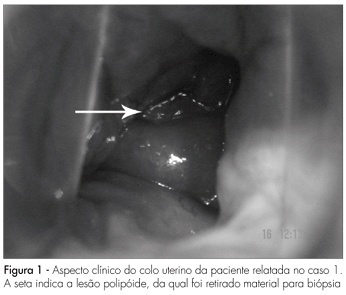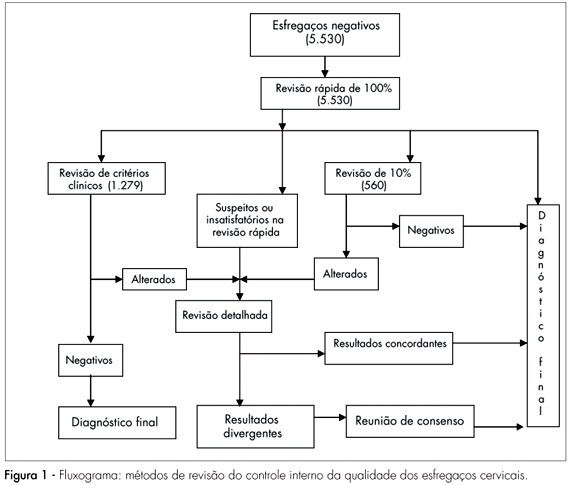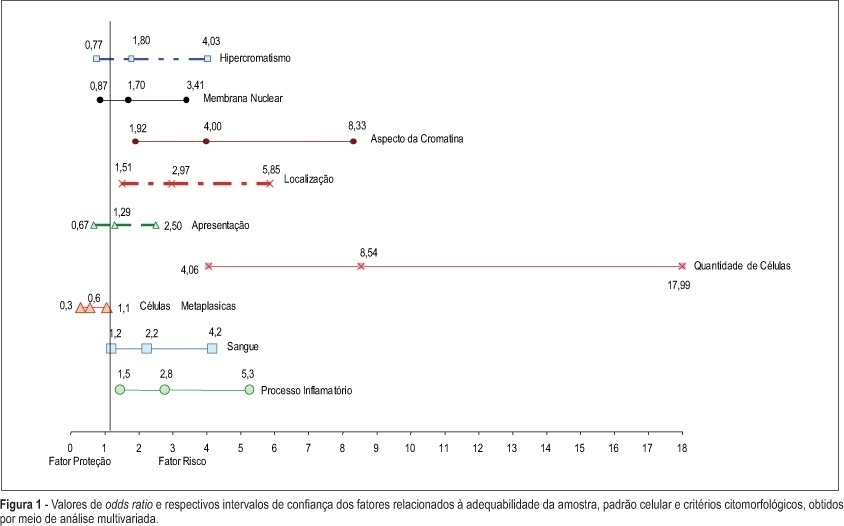Summary
Revista Brasileira de Ginecologia e Obstetrícia. 2009;31(1):22-27
DOI 10.1590/S0100-72032009000100005
PURPOSE: to analyze complications, morbidity, mortality and survival rate in a group of patients with cervical cancer with central pelvic relapse after primary radiotherapy treatment. METHODS: retrospective study of a series of 16 cases of pelvic exenteration after primary radiotherapy treatment. Descriptive statistics, survival curve through Kaplan-Meier's method, and regression analysis to evaluate prognosis were performed. RESULTS: sixteen patients have undergone pelvic exenteration. Epidermoid carcinoma, IIb stage and undifferentiated grade were the most frequent conditions. Post-operatory tumor relapse occurred in half the cases. Eleven patients presented peri or post-surgical complications, the most frequent being pelvic infection, that of the surgical wound, and urinary fistulae. Global survival rate was 64.3%, with average follow-up of 11 months. Regression analysis did not detect any significant prognosis factor for the patient survival. CONCLUSIONS: the survival rate was 64.3%. No particular factor associated to poor prognosis has been found in the present series of cases.
Summary
Revista Brasileira de Ginecologia e Obstetrícia. 2008;30(12):626-630
DOI 10.1590/S0100-72032008001200007
The occurrence of primary lymphomas of the female genital tract is rare. The diagnosis is usually not possible by the cytological examination; a tissue biopsy is necessary. The present paper reports two patients referred to our service with a diagnosis of cervical lymphoma. In one of them, the diagnostic difficulties are demonstrated. Both patients were submitted to chemotherapy with satisfactory post-operatory period. There is no standard treatment for uterine lymphomas. Exclusive local treatment is supported by some reports in the literature in clinical stage IE, while others prefer systemic treatment irrespective of clinical stage.

Summary
Revista Brasileira de Ginecologia e Obstetrícia. 2008;30(11):556-560
DOI 10.1590/S0100-72032008001100005
PURPOSE: to evaluate whether the sample adequacy influences the detection of precursor cervical cancer lesions. METHODS: a transversal study from January 2004 to December 2005. A number of 10,951 results of cervical cytotopathological exams from users of the National Health System (Sistema Único de Saúde, SUS) in Goiânia, Goiás , Brazil, was studied. These women had spontaneously looked for the services from the Family Health Program or from the Basic Units of Health. Samples were collected by medical doctors and nurses, through the conventional technique to detect cervical cancer. The analyzed smears were classified by the Bethesda System, the sample adequacy being defined along the routine screening and categorized as: satisfactory, satisfactory but presenting factors that might partially jeopardize the analysis, and unsatisfactory. Results were stored in the Epi-Info 3.3.2 program. The χ2 test was used to compare altered results with the adequacy of the samples from cytopathological smears. Differences with probability of rejection of the null hypothesis lower than 5% (p<0.05) were considered as significant. RESULTS: From 10,951 smears, 51.1% were classified as having satisfactory adequacy for analysis, 46.6% as satisfactory, but presenting some limiting factors, and 2.3%, as unsatisfactory. The main factors which have partially jeopardized the analysis were: lack of endocervical cells (52.2%), dried smears (22.8%), purulence (14.9%), or smears with some thick areas (9.5%). There was a higher rate of altered smears when the sample had been classified as satisfactory for analysis and with representation of endocervical cells ASC-US (2.3%), ASC-H (0.6%), LSIL (3.2%), HSIL (1.7%) and 0.3% of AGC. Differences were significant when p=0.001. The rate of low and high grade lesions was higher when the smears were satisfactory for analysis. CONCLUSIONS: the rate of precursor uterine cervix cancer lesions varies according to the sample adequacy, and the main adequacy limitations of the sample are mainly related to the collection condition.
Summary
Revista Brasileira de Ginecologia e Obstetrícia. 2008;30(5):248-255
DOI 10.1590/S0100-72032008000500007
PURPOSE: to describe the socio-demographic characteristics of deaths caused by uterine cervix cancer in women living in Recife, Pernambuco, Brazil, from 2000 to 2004. METHODS: a transversal populational study, including 323 deaths by uterine cervix cancer, among which 261 were recorded in the Information System about Mortality and 62 were identified after investigation on deaths by cancer at non-specified sites of the uterus. Mortality rate for all the variables was obtained and statistics for central tendency and variance were calculated. The χ2 test was performed to obtain the mortality coefficient concerning the living place and age range of the patients. RESULTS: death among women under 60 (54.7%), black (60.5%), single (67.6%), housewives (71.2%) and the ones living in poor neighborhood (53.3%) preponderated. Most of deaths occurred in hospitals (85.1%) and 90.2% of them occurred inside national health system hospitals. The mortality coefficient varied from 0.3 (among women under 30) to 54.9/100.00 (among women over 80). Significant statistical differences (p<0.05) were evidenced when death linked to age range and sanitary district was compared to characteristics of the female population living in the city. CONCLUSIONS: in Recife, death by cervix cancer are more frequent among adult, black, single, housewives, women living in poor neighborhoods and attended to at national health system hospitals, with differences in death risk among age ranges and living place.
Summary
Revista Brasileira de Ginecologia e Obstetrícia. 2007;29(11):580-587
DOI 10.1590/S0100-72032007001100006
PURPOSE: to investigate women’s age at their first sexual intercourse and its correlation with their present age, human papillomavirus (HPV) infection and cytological abnormalities at Pap smear. METHODS: women from the general population were invited to be screened for cervical cancer and pre-malignant lesions. After answering a behavior questionnaire, they were submitted to screening with cervical cytology and high-risk HPV testing with Hybrid Capture 2 (HC2). This report is part of the Latin American Screening (LAMS) study, that comprises centers from Brazil and Argentina, and the data presented herein refer to the Brazilian women evaluated at the cities of Porto Alegre, São Paulo and Campinas. RESULTS: from 8,649 women that answered the questionnaire, 8,641 reported previous sexual activity and were included in this analysis. The mean age at the interview was 38.1±11.0 years and the mean age at the first sexual intercourse was 18.5±4.0 years. The age at the first sexual intercourse increased along with the age at the interview, i.e., younger women reported they had begun their sexual life earlier than older women (p<0.001). From the total of women who had already begun having sexual intercourse, 3,643 patients were tested for high-risk HPV infection and 17.3% of them had positive results. In all the centers, it became clear that the women with the first sexual intercourse at ages below the mean age of all the population interviewed presented higher rates of HPV infection (20.2%) than the women with the first sexual intercourse at ages above the mean (12.5%) - Odds Ratio (OR) 1.8 (IC95% 1.5-2.2;p<0,001). According to the cytology, the women with first sexual intercourse at ages under the mean, presented higher percentage of abnormal cytology > or = ASC-US (6.7%) than the women with the first sexual intercourse at ages above the mean (4.3%) - OR 1.6 (IC95% 1.3-2.;p<0.001). CONCLUSIONS: the high-risk HPV infection and cytological abnormalities identified during the asymptomatic population screening were significantly associated to the women’s age at the first sexual intercourse. Additionally, we have also identified that the women’s age at the first sexual intercourse has decreased during the last decades, suggesting an important contribution to the increase of HPV infection and the subsequent cervical lesions.

Summary
Revista Brasileira de Ginecologia e Obstetrícia. 2007;29(8):402-407
DOI 10.1590/S0100-72032007000800004
PURPOSE: to evaluate the efficiency of the 100% rapid rescreening in the detection of false-negative results and to verify whether the results vary according to the adequacy of the sample and the woman’s age group. METHODS: to evaluate the efficiency of the rapid rescreening, the 5,530 smears classified as negative by the routine screening, after being submitted to the rapid rescreening of 100%, were compared with the rescreening of the smears on the basis of clinical criteria and 10% random rescreening. For statistical analysis, the variables were evaluated descriptively and the c² test and the Cochran-Armitage test were applied to compare results. RESULTS: of the 141 smears identified as suspicious according to the rapid rescreening method, 84 (59.6%) cases were confirmed in the final diagnosis, of which 36 (25.5%) were classified as atypical squamous cells of undetermined significance, five (3.5%) as atypical squamous cells that cannot exclude high-grade squamous intraepithelial lesion, 34 (24.1%) as low-grade squamous intraepithelial lesion, six (4.3%) as high-grade squamous intraepithelial lesion, and three (2.1%) as atypical glandular cells. Of the 84 suspect smears confirmed in the final diagnosis, 62 (73.8%) smears were classified as adequate and 22 (26.2%) as adequate but with some limitation, but no significant difference was observed with the woman’s age. CONCLUSIONS: the results of this study show that rapid rescreening is an efficient option for internal quality control for the detection of false-negative cervical smear results. In addition, it should be noted that rapid rescreening performed better when the sample was classified as adequate for analysis; however, it did not vary according to the woman’s age group.

Summary
Revista Brasileira de Ginecologia e Obstetrícia. 2007;29(2):85-90
DOI 10.1590/S0100-72032007000200005
Summary
Revista Brasileira de Ginecologia e Obstetrícia. 2006;28(8):479-485
DOI 10.1590/S0100-72032006000800007
PURPOSE: to evaluate whether factors related to the adequacy of the sample, cell pattern and cytomorphological criteria are associated with false-negative (FN) results of cervical cytopathology during routine examinations. METHODS: this is a case-control study in which the study group included 100 cytopathologic smears with FN results detected during systematic internal quality control consisting of 100% rapid review. For each FN result detected, two smears with a true-positive diagnosis were identified by the same cytotechnician and these constituted the control group, making a total sample size of 300 smears. The variables were established in accordance with the criteria defined for the analysis of sample adequacy, cell pattern and cytomorphological analyzed criteria. The results were evaluated using bivariate analysis and logistic regression with stepwise variable selection criteria expressed in OR (95%). RESULTS: the number of atypical cells, the appearance of nuclear chromatin, and the distribution and presentation of atypical cells in the smear were the variables that showed the greatest risk for FN results with OR of 9.6, 4.2, 4.4, and 3.6, respectively. Inflammatory processes and the presence of blood in the smear were also identified as variables that influence the risk of FN results. CONCLUSIONS: the majority of the factors associated with FN results are dependent on the conditions and techniques of sample collection, since in the majority of cases, the lesion may not be adequately represented in the smear. Confounding factors such as blood and inflammatory processes may also impair analysis. With respect to cytomorphological alterations, thin chromatin strand was the variable that indicated the greatest risk of FN results.
